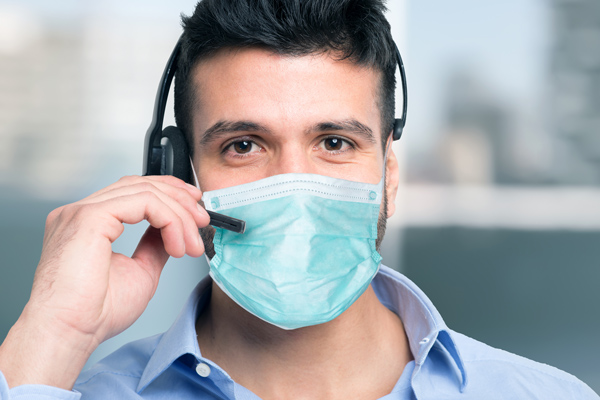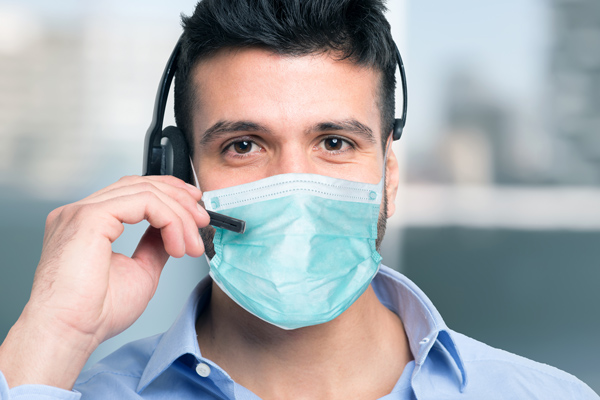Overview
- Voice technology supports warehouse safety measures such as social distancing and reducing touching of shared surfaces.
- Consider assigning one headset to each worker to reduce the risk of transmission.
- If wearing masks, consider retraining the voice technology and conducting periodic quality control checks.

As you probably know firsthand, operations have had to make many modifications to stay up and running because of COVID-19. You may have adopted social distancing and advanced hygiene measures while managing more remote workers than usual.
You may also know that mobile devices have become a key part of this new supply chain. I’ve personally seen how mobile phones and tablets are becoming the next generation of PPE with our customers. Workers now rely on them more than ever to work safely while also keeping up with increased demand.
However, many of our customers are also now requiring workers to wear masks to reduce the chance of virus spread. If you use voice technology for picking, packing, shipping, etc., you may be wondering how such policies will affect its voice recognition and performance.
Skip To: Tips for Using Voice Technology with Masks »
Let me walk you through how voice technology supports COVID safety in the warehouse. Then, I’ll discuss some key tips for using voice technology with masks, courtesy of Honeywell.
Read More: COVID-19 and the Supply Chain’s New Normal: How Mobile Barcoding Can Help »
Meeting Guidelines for a Safer Return to Work
As operations ramp up production and increase the number of onsite staff, they’re also having to prioritize warehouse safety measures.
This includes adhering to CDC guidelines for a safer return to work:
- Keeping workers six feet apart,
- Increasing the availability of hand washing stations or hand sanitizer dispensers,
- Ensuring adequate ventilation,
- Discouraging use of break rooms, and
- Wearing masks.

Failure to follow these guidelines can also lead to OSHA violations, resulting in monetary penalties, increased inspections and oversight, and possible production delays.
Read Similar: How We Can Keep Our Essential Supply Chain Workforce Safe »
How Voice Technology Supports Your Warehouse Safety
Voice technology, such as Honeywell Voice mobile devices and headsets, coupled with mobile barcoding, are already designed to support these new warehouse safety measures. And I’ve been proud to watch our customers modify their operations quickly and efficiently using this technology to adapt to the challenges brought by COVID-19.
Voice technology, like mobile barcoding, enables you to digitize paper-based recording processes. By eliminating paper processes, you can also eliminate the hand-to-hand paper transfers and typing into a shared workstation that could increase virus transmission. Voice technology with mobile barcoding mobilizes workers to when and where they work, so they can update the ERP in real-time. This eliminates extra manual steps such as writing, scanning, and emailing inventory counts and workflows to offsite administrative staff.
Voice technology augments smaller workforces by increasing accuracy to as much as near 100% and productivity as much as 50%. It also better supports social distancing, as workers can more easily stay farther apart from each other using voice-directed workflows.
Warehouse Voice Technology and COVID-19
To help reduce the chance of spreading COVID-19 in your warehouse, I recommend assigning a headset and microphone to only one person and avoiding sharing the devices with other workers. However, I know this isn’t possible for some operations.
If you must share the devices between two or more individuals, make sure both the headset and microphone are cleaned thoroughly between shifts. Honeywell recommends using isopropyl alcohol in a 70% solution only. I also recommend using gloves with headsets at all times in the warehouse.
Tips for Using Warehouse Voice Technology with Masks

If you use voice technology and your workers must wear masks at all times, you might be wondering if the voice recognition capabilities will still be able to function.
The answer is: Yes.
According to Honeywell, any interference from the mask should be minimal and the speech recognition software should continue to work as normal. And in fact, operations around the world have already been using masks with their technology for years, particularly in the food and beverage industry. These workers often have to go into deep freezers to complete inventory counts and have to wear an entire face covering on which their headset sits on top of.
Honeywell also recommends these three tips to consider when using masks with their voice technology:
- If you’re using a trained template, your workers may need to re-train the template while wearing their masks. This will help boost accuracy.
- There should be no need to retain if you’re using the Pick-Up & Go speaker independent recognition unless speech recognition issues occur. Then retain using the mask, as above.
- Supervisors should take noise samples periodically to ensure clarity and accuracy, especially if you make any additional changes to your work environment.
Conclusion
Voice technology can greatly enhance warehouse productivity in normal circumstances. With the smaller workforces and social distancing requirements brought by the pandemic, they can help businesses remain operational, improve functionality, and support worker safety.
If your workers are wearing masks, make sure to plan for any template retraining needed and double-check for accuracy as workers get used to it.
If you’re interested in learning about some of our other hardware tips and tricks, check out my other hardware articles:






